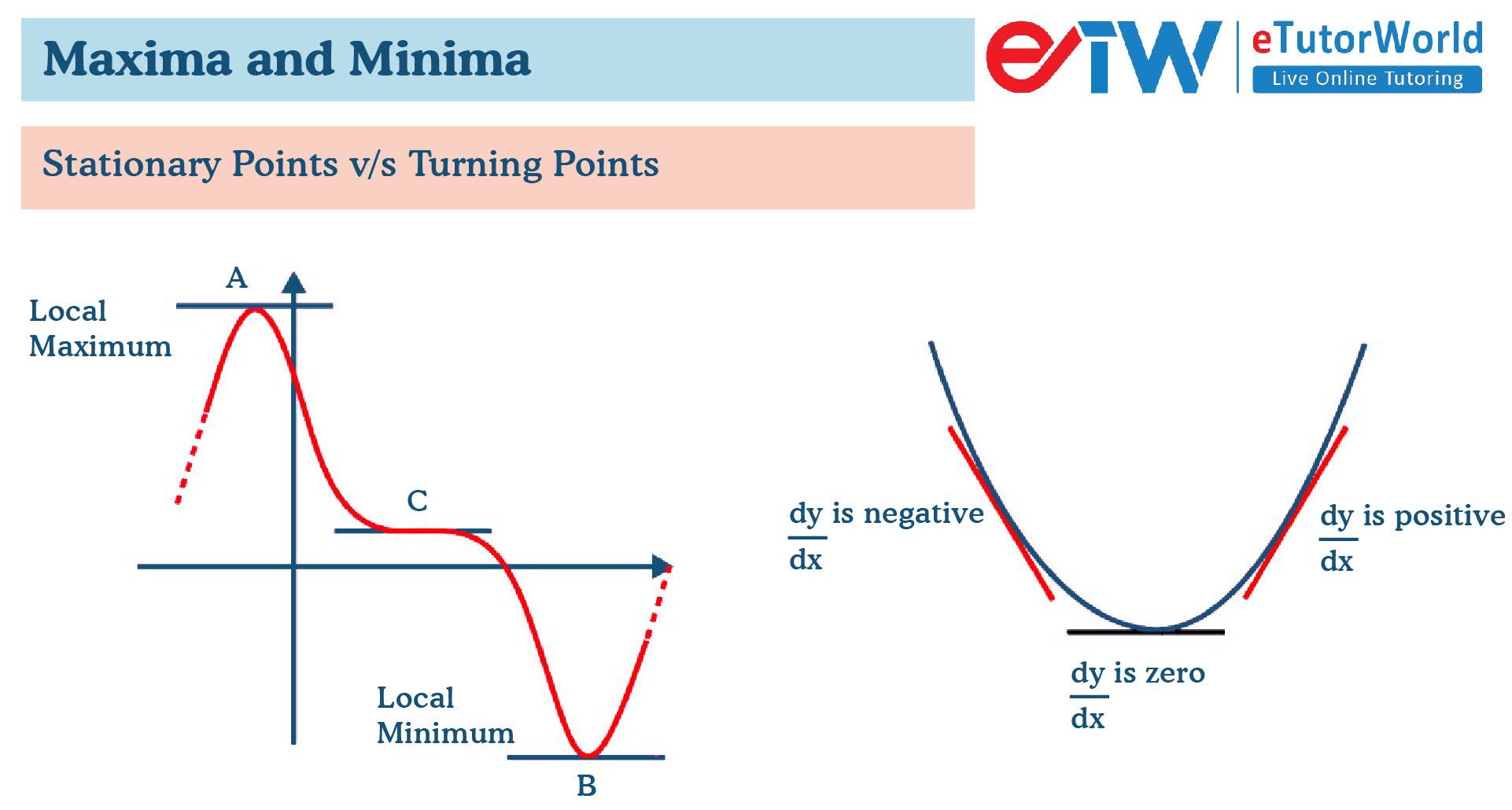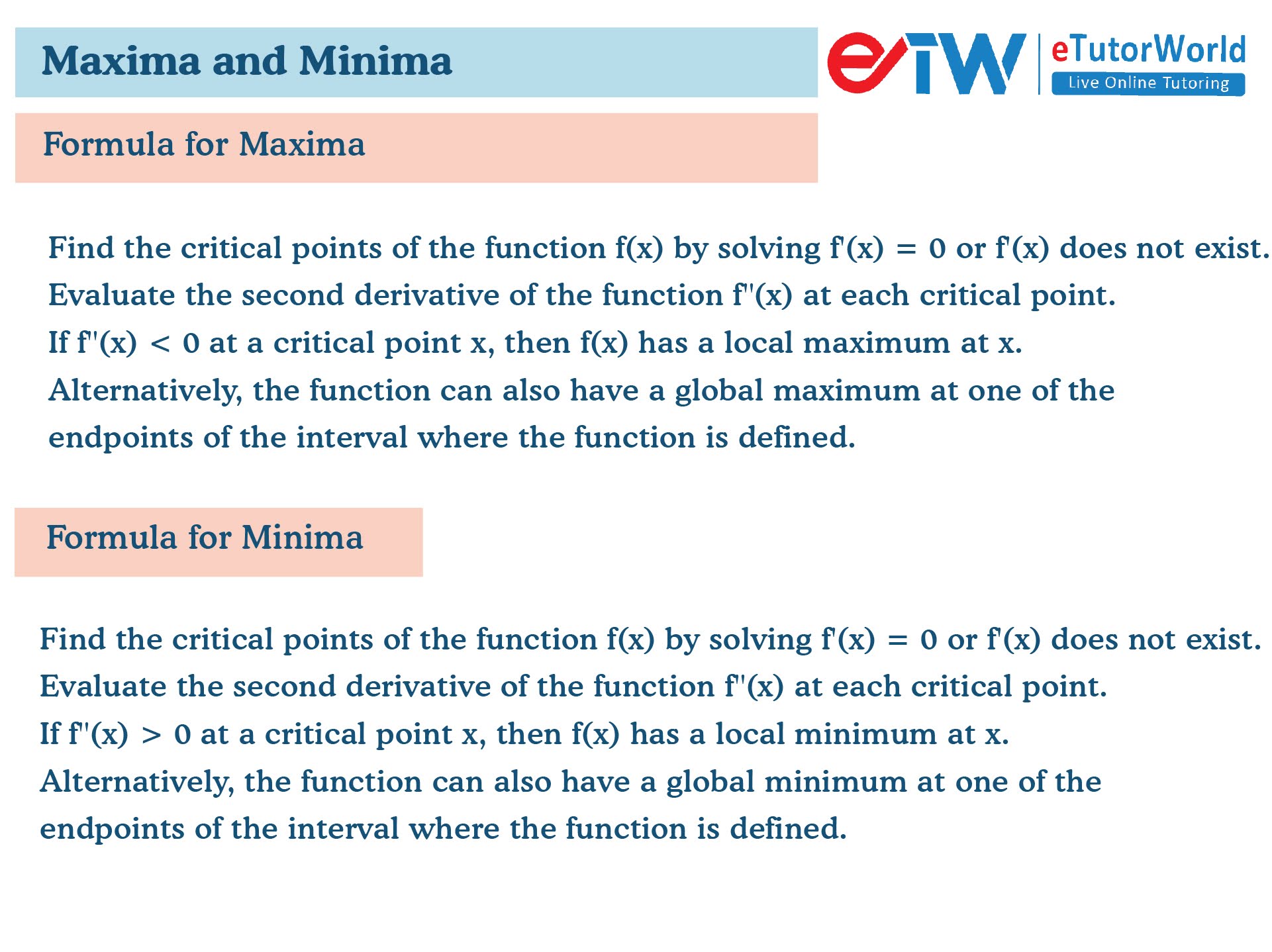Maxima and Minima
Grade 8 Math Worksheets
Maxima and minima are the highest and lowest values, respectively, that a function or a set of data can reach. In calculus, maxima and minima are important concepts in optimization problems and in finding critical points of functions.
Table of Contents:
- Maxima and Minima
- Formula for Maxima
- Solved Examples for Maxima and Minima
- FAQs
Personalized Online Tutoring
Maxima and Minima Worksheet PDF
This is a free worksheet with practice problems and answers. You can also work on it online.
Sign up with your email ID to access this free worksheet.
"We really love eTutorWorld!"
"We really love etutorworld!. Anand S and Pooja are excellent math teachers and are quick to respond with requests to tutor on any math topic!" - Kieran Y (via TrustSpot.io)
"My daughter gets distracted easily"
"My daughter gets distracted very easily and Ms. Medini and other teachers were patient with her and redirected her back to the courses.
With the help of Etutorworld, my daughter has been now selected in the Gifted and Talented Program for the school district"
- Nivea Sharma (via TrustSpot.io)
Maxima and Minima
Here are some key points to keep in mind about maxima and minima:
A function can have multiple maxima and minima, or none at all.
The maxima and minima of a function occur at critical points, which are points where the derivative of the function is zero or undefined.
The maxima and minima of a function can also occur at endpoints of a closed interval, such as in a constrained optimization problem.
To find the maxima and minima of a function, you can use techniques such as the first and second derivative tests, or optimization methods such as linear programming or dynamic programming.
In summary, maxima and minima are important concepts in calculus and optimization, and they can help us find optimal solutions to problems in various fields, such as economics, engineering, and physics.
Formula for Maxima
The formula for finding maxima of a function using calculus involves finding the critical points of the function and then evaluating the second derivative of the function at those points. If the second derivative is negative, then the critical point is a local maximum. The formula can be written as:
Find the critical points of the function f(x) by solving f'(x) = 0 or f'(x) does not exist.
Evaluate the second derivative of the function f”(x) at each critical point.
If f”(x) < 0 at a critical point x, then f(x) has a local maximum at x.
Alternatively, the function can also have a global maximum at one of the endpoints of the interval where the function is defined.
Note that finding the maxima of a function can be more complex for multivariable functions, where partial derivatives and Hessian matrices are used to find critical points and determine the nature of those critical points.
“There have been times when we booked them last minute, but the teachers have been extremely well-prepared and the help desk at etutorworld is very prompt.
Our kid is doing much better with a higher score.”
8th Grade Tutoring
eTutorWorld offers Personalized Online Tutoring for Math, Science, English, and Standardised Tests.
Our Tutoring Packs start at just under $22.49 per hour, and come with a moneyback guarantee.
Schedule a FREE Trial Session, and experience quality tutoring for yourself. (No credit card required.)
Solved Examples for Maxima & Minima
Here are some examples of finding maxima and minima of functions:
Example 1: Find the local maxima and minima of the function f(x) = x^3 – 3x^2 + 2x.
Solution: To find the critical points, we need to find where the derivative is zero or undefined:
f'(x) = 3x^2 – 6x + 2 = 0
Solving for x, we get x = 1 ± sqrt(2)/3.
These are the critical points. Now we need to evaluate the second derivative at each point to determine whether it is a local maximum or minimum:
f”(x) = 6x – 6
At x = 1 – sqrt(2)/3, f”(x) < 0, so this is a local maximum.
At x = 1 + sqrt(2)/3, f”(x) > 0, so this is a local minimum.
Therefore, the function has a local maximum at x = 1 – sqrt(2)/3 and a local minimum at x = 1 + sqrt(2)/3.
Example 2: Find the global maximum and minimum of the function f(x) = x^2 – 4x + 3 on the interval [0, 3].
Solution: Since the interval is closed, we also need to check the endpoints.
f(0) = 3
f(3) = 0
To find the critical points, we need to find where the derivative is zero or undefined:
f'(x) = 2x – 4 = 0
Solving for x, we get x = 2.
This is the only critical point in the interval [0, 3]. Now we need to evaluate the second derivative at this point to determine whether it is a global maximum or minimum:
f”(x) = 2 > 0, so x = 2 is a global minimum.
Therefore, the function has a global minimum of -1 at x = 2, and a global maximum of 3 at x = 0.
Example 3: Find the maximum and minimum values of the function f(x) = x^3 – 6x^2 + 9x + 2 on the interval [-1, 4].
Solution: We start by checking the endpoints of the interval:
f(-1) = 10
f(4) = 10
Next, we find the critical points by finding where the derivative is zero or undefined:
f'(x) = 3x^2 – 12x + 9 = 0
Solving for x, we get x = 1 or x = 3.
These are the critical points. Now we need to evaluate the second derivative at each point to determine whether it is a maximum or minimum:
f”(x) = 6x – 12
At x = 1, f”(x) < 0, so this is a local maximum.
At x = 3, f”(x) > 0, so this is a local minimum.
Therefore, the function has a local maximum of 10 at x = -1, a local maximum of 13 at x = 1, and a local minimum of -8 at x = 3.
Thus, the maximum value of the function on the interval [-1, 4] is 13, and the minimum value is -8.
Do You Stack Up Against the Best?
If you have 30 minutes, try our free diagnostics test and assess your skills.
Maxima and Minima FAQS
What is the difference between local maxima/minima and global maxima/minima?
Local maxima/minima are points on a graph where the function reaches its highest or lowest point in a local area, while global maxima/minima are the highest or lowest point on the entire graph or an interval. A local maximum is higher than all nearby points, but there may be a higher point further away. Similarly, a local minimum is lower than all nearby points, but there may be a lower point further away. A global maximum or minimum is the highest or lowest point on the entire graph or an interval.
How do you find the critical points of a function?
The critical points of a function are the points where the derivative of the function is zero or undefined. To find the critical points, you need to take the derivative of the function, set it equal to zero, and solve for x. If the derivative is undefined at a point, you should also check whether the function has a vertical tangent at that point.
How do you determine whether a critical point is a maximum or minimum?
To determine whether a critical point is a maximum or minimum, you need to evaluate the second derivative of the function at that point. If the second derivative is positive, the critical point is a local minimum. If the second derivative is negative, the critical point is a local maximum. If the second derivative is zero, the test fails and you need to use another method to determine whether the point is a maximum or minimum.
What is a stationary point?
A stationary point is a point on a graph where the slope of the tangent is zero. Stationary points include local maxima/minima and points where the function changes direction (inflection points).

Gloria Mathew writes on math topics for K-12. A trained writer and communicator, she makes math accessible and understandable to students at all levels. Her ability to explain complex math concepts with easy to understand examples helps students master math. LinkedIn
Affordable Tutoring Now Starts at Just $22.49
eTutorWorld offers affordable one-on-one live tutoring over the web for Grades K-12. We are also a leading provider of Test Prep help for Standardized Tests (SCAT, CogAT, MAP, SSAT, SAT, ACT, ISEE, and AP).
What makes eTutorWorld stand apart are: flexibility in lesson scheduling, quality of hand-picked tutors, assignment of tutors based on academic counseling and diagnostic tests of each student, and our 100% money-back guarantee.
Whether you have never tried personalized online tutoring before or are looking for better tutors and flexibility at an affordable price point, schedule a FREE TRIAL Session with us today.
*There is no purchase obligation or credit card requirement
Grade 8 Science Worksheets
- Earth & Space Science
- Physical Science
- Life Science
- Chemistry
- Structure of Atom (Basic)
- Fossils
- Bio Classification
- Sedimentary Rock
- Chemical Reaction
- Climate
- Compounds and Mixtures
- The Universe
- Dynamics of our solar system
- Organization of the universe, and its development
- Earth Systems
- Rocks and Fossils
- Sources of energy that power the subsystems and cycles of the dynamic earth: the geosphere, hydrosphere, atmosphere and biosphere
- Heredity
- Evolutionary Theory
- Structure and function of the cell.
- Chromosomes, genes, and the molecular basis of heredity
- Interdependence of organisms and their interaction with the physical environment
- Behavior of animals
- Understanding biological evolution
- How Living things are classified
- How Living Systems live
- Life Cycle of living things
- Structure of the atom
- States and properties of matter
- Changes in States Of Matter
- Chemical properties of Matter
- Structure of matter
- Conservation of matter
- Basics of chemical reactions
- Forces and Motion
- Laws and Formulas Of Motion
IN THE NEWS

Our mission is to provide high quality online tutoring services, using state of the art Internet technology, to school students worldwide.
Online test prep and practice
SCAT
SSAT
ISEE
PSAT
SAT
ACT
AP Exam
Science Tutoring
Physics Tutoring
Chemistry Tutoring
Biology Tutoring
Math Tutoring
Pre-Algebra Tutoring
Algebra Tutoring
Pre Calculus Tutoring
Calculus Tutoring
Geometry Tutoring
Trigonometry Tutoring
Statistics Tutoring
Quick links
Free Worksheets
Fact sheet
Sales Partner Opportunities
Parents
Passive Fundraising
Virtual Fundraising
Our Expert Tutors
Safe and Secure Tutoring
Interactive Online Tutoring
After School Tutoring
Elementary School Tutoring
Middle School Tutoring
High School Tutoring
Home Work Help
Math Tutors New York City
Press
©2022 eTutorWorld Terms of use Privacy Policy Site by Little Red Bird
©2022 eTutorWorld
Terms of use
Privacy Policy
Site by Little Red Bird











